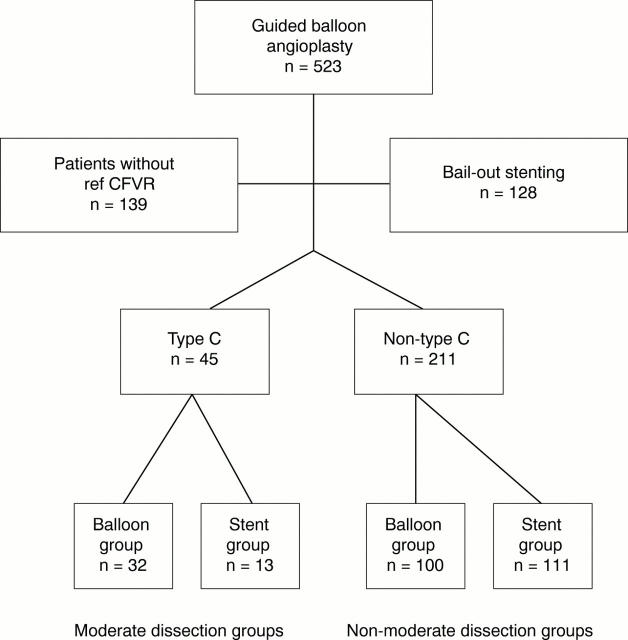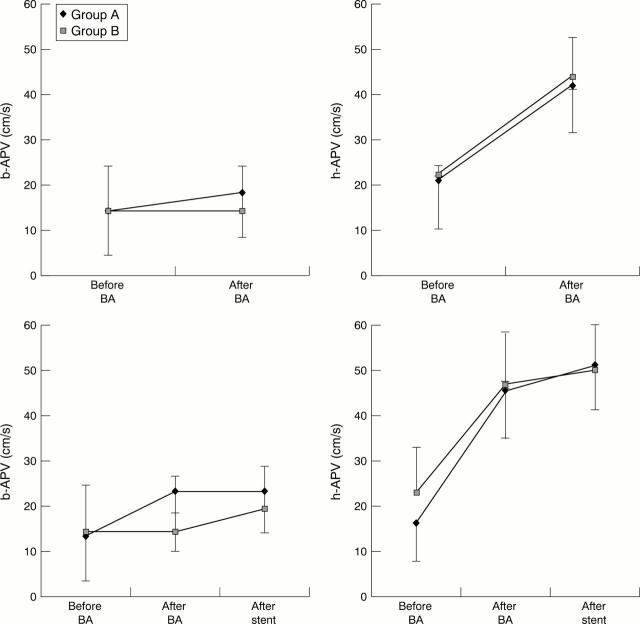Abstract
OBJECTIVE—To study the relation between moderate coronary dissections, coronary flow velocity reserve (CFVR), and long term outcome. METHODS—523 patients undergoing balloon angioplasty and sequential intracoronary Doppler measurements were examined as part of the DEBATE II trial (Doppler endpoints balloon angioplasty trial Europe). After successful balloon angioplasty, patients were randomised to stenting or no further treatment. Dissections were graded at the core laboratory by two observers and divided into four categories: none, mild (type A-B), moderate (type C), severe (types D to F). Patients with severe dissections (n = 128) or without available reference vessel CFVR (n = 139) were excluded. The remaining 256 patients were divided into two groups according to the presence (group A, n = 45) or absence (group B, n = 211) of moderate dissection. RESULTS—Following balloon angioplasty, there was no difference in CFVR between the two groups. At 12 months follow up, a higher rate of major adverse cardiac events was observed overall in group A than in group B (10 (22%) v 23 (11%), p = 0.041). However, the risk of major adverse events was similar in the subgroups receiving balloon angioplasty (group A, 6 (19%) v group B, 16 (16%), NS). Among group A patients, the adverse events risk was greater in those randomised to stenting (odds ratios 6.603 v 1.197, p = 0.046), whereas there was no difference in risk if the group was analysed according to whether the CFVR was < 2.5 or ⩾ 2.5 after balloon angioplasty. CONCLUSIONS—Moderate dissections left untreated result in no increased risk of major adverse cardiac events. Additional stenting does not improve the long term outcome. Keywords: coronary dissection; intracoronary Doppler; angioplasty
Full Text
The Full Text of this article is available as a PDF (146.9 KB).
Figure 1 .
Study population. All patients allocated to the guided balloon angioplasty group of the DEBATE II trial who did not require bail out stenting formed the population for our substudy (395 patients). Of these, 139 had no data of the reference vessel coronary flow velocity reserve available and were therefore excluded from further analysis. The remaining 256 patients underwent a second randomisation to additional stenting or termination of the procedure. We analysed these patients depending on the presence (group A) or absence (group B) of uncomplicated "moderate" dissections.
Figure 2 .
Baseline (b-APV) and hyperaemic (h-APV) average peak velocities before and after the procedure in group A and group B. Upper panels show the subgroup randomised to stopping the procedure after balloon angioplasty (BA); lower panels show the subgroup randomised to further stent implantation (stent).
Selected References
These references are in PubMed. This may not be the complete list of references from this article.
- Albertal M., Van Langenhove G., Kay I. P., Costa M. A., Kozuma K., Serruys P. W. Angiographic and clinical outcome of mild to moderate nonocclusive unstented coronary artery dissection and the influence on coronary flow velocity reserve. The Debate I Study Group. Am J Cardiol. 2000 Aug 15;86(4):375–378. doi: 10.1016/s0002-9149(00)00949-8. [DOI] [PubMed] [Google Scholar]
- Baumgart D., Haude M., Goerge G., Ge J., Vetter S., Dagres N., Heusch G., Erbel R. Improved assessment of coronary stenosis severity using the relative flow velocity reserve. Circulation. 1998 Jul 7;98(1):40–46. doi: 10.1161/01.cir.98.1.40. [DOI] [PubMed] [Google Scholar]
- Cappelletti A., Margonato A., Rosano G., Mailhac A., Veglia F., Colombo A., Chierchia S. L. Short- and long-term evolution of unstented nonocclusive coronary dissection after coronary angioplasty. J Am Coll Cardiol. 1999 Nov 1;34(5):1484–1488. doi: 10.1016/s0735-1097(99)00395-2. [DOI] [PubMed] [Google Scholar]
- Caramori P. R., Lima V. C., Seidelin P. H., Newton G. E., Parker J. D., Adelman A. G. Long-term endothelial dysfunction after coronary artery stenting. J Am Coll Cardiol. 1999 Nov 15;34(6):1675–1679. doi: 10.1016/s0735-1097(99)00411-8. [DOI] [PubMed] [Google Scholar]
- Costa M. A., Kozuma K., Gaster A. L., van Der Giessen W. J., Sabaté M., Foley D. P., Kay I. P., Ligthart J. M., Thayssen P., van Den Brand M. J. Three dimensional intravascular ultrasonic assessment of the local mechanism of restenosis after balloon angioplasty. Heart. 2001 Jan;85(1):73–79. doi: 10.1136/heart.85.1.73. [DOI] [PMC free article] [PubMed] [Google Scholar]
- Di Mario C., Haase J., den Boer A., Reiber J. H., Serruys P. W. Edge detection versus densitometry in the quantitative assessment of stenosis phantoms: an in vivo comparison in porcine coronary arteries. Am Heart J. 1992 Nov;124(5):1181–1189. doi: 10.1016/0002-8703(92)90398-f. [DOI] [PubMed] [Google Scholar]
- Dorros G., Cowley M. J., Simpson J., Bentivoglio L. G., Block P. C., Bourassa M., Detre K., Gosselin A. J., Grüntzig A. R., Kelsey S. F. Percutaneous transluminal coronary angioplasty: report of complications from the National Heart, Lung, and Blood Institute PTCA Registry. Circulation. 1983 Apr;67(4):723–730. doi: 10.1161/01.cir.67.4.723. [DOI] [PubMed] [Google Scholar]
- Ellis S. G., Savage M., Fischman D., Baim D. S., Leon M., Goldberg S., Hirshfeld J. W., Cleman M. W., Teirstein P. S., Walker C. Restenosis after placement of Palmaz-Schatz stents in native coronary arteries. Initial results of a multicenter experience. Circulation. 1992 Dec;86(6):1836–1844. doi: 10.1161/01.cir.86.6.1836. [DOI] [PubMed] [Google Scholar]
- Farb A., Sangiorgi G., Carter A. J., Walley V. M., Edwards W. D., Schwartz R. S., Virmani R. Pathology of acute and chronic coronary stenting in humans. Circulation. 1999 Jan 5;99(1):44–52. doi: 10.1161/01.cir.99.1.44. [DOI] [PubMed] [Google Scholar]
- Haase J., Di Mario C., Slager C. J., van der Giessen W. J., den Boer A., de Feyter P. J., Reiber J. H., Verdouw P. D., Serruys P. W. In-vivo validation of on-line and off-line geometric coronary measurements using insertion of stenosis phantoms in porcine coronary arteries. Cathet Cardiovasc Diagn. 1992 Sep;27(1):16–27. doi: 10.1002/ccd.1810270106. [DOI] [PubMed] [Google Scholar]
- Hanke H., Kamenz J., Hassenstein S., Oberhoff M., Haase K. K., Baumbach A., Betz E., Karsch K. R. Prolonged proliferative response of smooth muscle cells after experimental intravascular stenting. Eur Heart J. 1995 Jun;16(6):785–793. doi: 10.1093/oxfordjournals.eurheartj.a060997. [DOI] [PubMed] [Google Scholar]
- Haude M., Erbel R., Straub U., Dietz U., Meyer J. Short and long term results after intracoronary stenting in human coronary arteries: monocentre experience with the balloon-expandable Palmaz-Schatz stent. Br Heart J. 1991 Nov;66(5):337–345. doi: 10.1136/hrt.66.5.337. [DOI] [PMC free article] [PubMed] [Google Scholar]
- Hermans W. R., Rensing B. J., Foley D. P., Deckers J. W., Rutsch W., Emanuelsson H., Danchin N., Wijns W., Chappuis F., Serruys P. W. Therapeutic dissection after successful coronary balloon angioplasty: no influence on restenosis or on clinical outcome in 693 patients. The MERCATOR Study Group (Multicenter European Research Trial with Cilazapril after Angioplasty to prevent Transluminal Coronary Obstruction and Restenosis). J Am Coll Cardiol. 1992 Oct;20(4):767–780. doi: 10.1016/0735-1097(92)90171-i. [DOI] [PubMed] [Google Scholar]
- Hofma S. H., Whelan D. M., van Beusekom H. M., Verdouw P. D., van der Giessen W. J. Increasing arterial wall injury after long-term implantation of two types of stent in a porcine coronary model. Eur Heart J. 1998 Apr;19(4):601–609. doi: 10.1053/euhj.1997.0753. [DOI] [PubMed] [Google Scholar]
- Huber M. S., Mooney J. F., Madison J., Mooney M. R. Use of a morphologic classification to predict clinical outcome after dissection from coronary angioplasty. Am J Cardiol. 1991 Aug 15;68(5):467–471. doi: 10.1016/0002-9149(91)90780-o. [DOI] [PubMed] [Google Scholar]
- Kasaoka S., Tobis J. M., Akiyama T., Reimers B., Di Mario C., Wong N. D., Colombo A. Angiographic and intravascular ultrasound predictors of in-stent restenosis. J Am Coll Cardiol. 1998 Nov 15;32(6):1630–1635. doi: 10.1016/s0735-1097(98)00404-5. [DOI] [PubMed] [Google Scholar]
- MacDonald R. G., Barbieri E., Feldman R. L., Pepine C. J. Angiographic morphology of restenosis after percutaneous transluminal coronary angioplasty. Am J Cardiol. 1987 Jul 1;60(1):50–54. doi: 10.1016/0002-9149(87)90983-0. [DOI] [PubMed] [Google Scholar]
- Rupprecht H. J., Brennecke R., Bernhard G., Erbel R., Pop T., Meyer J. Analysis of risk factors for restenosis after PTCA. Cathet Cardiovasc Diagn. 1990 Mar;19(3):151–159. doi: 10.1002/ccd.1810190302. [DOI] [PubMed] [Google Scholar]
- Schwartz R. S., Huber K. C., Murphy J. G., Edwards W. D., Camrud A. R., Vlietstra R. E., Holmes D. R. Restenosis and the proportional neointimal response to coronary artery injury: results in a porcine model. J Am Coll Cardiol. 1992 Feb;19(2):267–274. doi: 10.1016/0735-1097(92)90476-4. [DOI] [PubMed] [Google Scholar]
- Serruys P. W., di Mario C., Piek J., Schroeder E., Vrints C., Probst P., de Bruyne B., Hanet C., Fleck E., Haude M. Prognostic value of intracoronary flow velocity and diameter stenosis in assessing the short- and long-term outcomes of coronary balloon angioplasty: the DEBATE Study (Doppler Endpoints Balloon Angioplasty Trial Europe). Circulation. 1997 Nov 18;96(10):3369–3377. doi: 10.1161/01.cir.96.10.3369. [DOI] [PubMed] [Google Scholar]
- Sharma S. K., Israel D. H., Kamean J. L., Bodian C. A., Ambrose J. A. Clinical, angiographic, and procedural determinants of major and minor coronary dissection during angioplasty. Am Heart J. 1993 Jul;126(1):39–47. doi: 10.1016/s0002-8703(07)80008-1. [DOI] [PubMed] [Google Scholar]




